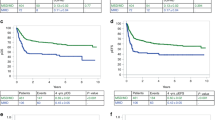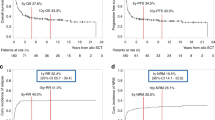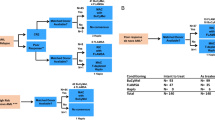Abstract
In 1402 patients allografted in Europe during the period 1990–2000 with an HLA-identical sibling in first remission (CR1), the median interval from CR1 to allotransplant (96 days) was a major prognostic factor, patients transplanted earlier having a worse outcome. We studied in depth the 414 fully evaluable patients transplanted less than 96 days after achieving CR1; in these patients, only three factors predicted for the outcome by multivariate analysis: patient age, CR1 achievement with one or more induction courses and the recipient/donor sex combination. These three factors overcame the information from cytogenetics and source of stem cells. Three prognostic groups could be identified in relation to the outcome, using a prognostic score affecting 1 to each poor risk factor (total from 0 to 3): Group 1 (good prognosis) includes patients <35 years old, achieving CR1 with one induction course and to be transplanted with any other sex combination than female to male (score 0); group 2 (intermediate) with one adverse factor (score 1); and group 3 (bad prognosis) with two or three adverse criteria (scores 2 and 3). In these three groups, the 3-year leukaemia-free survival was 56±5%, 48±4% and 29±4% and the overall survival was 65±5, 53±4 and 29±5%, respectively. Therefore, adult patients with ALL and a score of 0 or 1 are good candidates for an early transplant if they have an identical sibling donor. Patient age, response to induction and the sex of the HLA-identical family donor (if existing) are the strongest easy predictors of the outcome for an early transplant in an adult patient with ALL. No additional information is mandatory.
This is a preview of subscription content, access via your institution
Access options
Subscribe to this journal
Receive 12 print issues and online access
$259.00 per year
only $21.58 per issue
Buy this article
- Purchase on Springer Link
- Instant access to full article PDF
Prices may be subject to local taxes which are calculated during checkout


Similar content being viewed by others
References
Martin T, Gajewski J . Allogeneic stem cell transplantation for acute lymphocytic leukemia in adults. Hematol Oncol Clin N Am 2001; 1: 97–120.
Flowers ME, Kansu E, Sullivan KM . Pathophysiology and treatment of graft-versus-host disease. Hematol Oncol Clin N Am 1999; 13: 1091–1099.
Kaplan E, Meier P . Non parametric estimation from incomplete observations. J Am Stat Assoc 1958; 53: 457–481.
Cox D . Regression models and life tables. J R Stat Soc 1972; 34: 187–202.
Campana D, Yokota S, Coustan-Smith E, Hansen-Hagge TE, Janossy G, Bartram CR . The detection of residual acute lymphoblastic leukemia cells with immunologic methods and polymerase chain reaction: a comparative study. Leukemia 1990; 4: 609–614.
Campana D, Coustan-Smith E . Detection of minimal residual disease in acute leukemia by flow cytometry. Cytometry 1999; 38: 139–152.
Chen JS, Coustan-Smith E, Suzuki T, Neale GA, Mihara K, Pui CH et al. Identification of novel markers for monitoring minimal residual disease in acute lymphoblastic leukemia. Blood 2001; 97: 2115–2120.
Coustan-Smith E, Sancho J, Hancock ML, Boyett JM, Behm FG, Raimondi SC et al. Clinical importance of minimal residual disease in childhood acute lymphoblastic leukemia. Blood 2000; 96: 2691–2696.
Hoelzer D, Gokbuget N . Recent approaches in acute lymphoblastic leukemia in adults. Crit Rev Oncol Hematol 2000; 36: 49–58.
Mitterbauer G, Nemeth P, Wacha S, Cross NC, Schwarzinger I, Jaeger U . Quantification of minimal residual disease in patients with BCR-ABL- positive acute lymphoblastic leukaemia using quantitative competitive polymerase chain reaction. Br J Haematol 1999; 106: 634–643.
Faderl S, Kantarjian M, Talpaz M, Estrov Z . Clinical significance of cytogenetic abnormalities in adult acute lymphoblastic leukemia. Blood 1998; 91: 3995–4019.
Labopin M, Porcher R, Bittencourt H, Rocha V, Katsahian S, Latouche A et al. Competing risk analysis for patients undergoing allogeneic hemopoietic stem cell transplantation (HSCT). Bone marrow transplantation 2002; 29(Suppl. 2): 878a.
Gratwohl A, Hermans J, Goldman JM, Arcese W, Carreras E, Devergie A et al. Risk assessment for patients with chronic myeloid leukaemia before allogeneic blood or marrow transplantation. Chronic Leukemia Working Party of the European Group for Blood and Marrow Transplantation. Lancet 1998; 352: 1087–1092.
Stock VA . Management of adult acute lymphoblastic leukemia: moving toward a risk-adapted approach. Current Opin in Oncol 2001; 13: 14–20.
Gorin NC, Labopin M, Laporte JP, Douay L, Lopez M, Lesage S et al. Importance of marrow dose on posttransplant outcome in acute leukemia: models derived from patients autografted with mafosfamide-purged marrow at a single institution. Exp Hematol 1999; 27: 1822–1830.
Gorin NC . Autologous stem cell transplantation in acute lymphocytic leukemia. Stem Cells 2002; 20: 3–10.
Holowiecki J, Wojnar J, Krawczyk-Kulis M, Kruzel T, Markiewicz M, Kopera M et al. Allogeneic and autologous bone marrow transplantation in single centre experience. Bone Marrow Transplant 1998; 22(Suppl 4) S100–S103.
Powles R, Sirohi B, Treleaven J, Kulkarni S, Tait D, Singhal S et al. The role of posttransplantation maintenance chemotherapy in improving the outcome of autotransplantation in adult acute lymphoblastic leukemia. Blood 2002; 100: 1641–1647.
Martin T, Linker C . Autologous stem cell transplantation for acute lymphocytic leukemia in adults. Hematol Oncol Clin N Am 2001; 15: 121–143.
Snyder DS, Nademanee AP, O'Donnell MR, Parker PM, Stein AS, Margolin K et al. Long term follow up of 23 patients with Philadelphia chromosome positive acute lymphoblastic leukemia treated with allogeneic bone marrow transplant in first complete remission. Leukemia 1999; 13: 2053–2058.
Author information
Authors and Affiliations
Consortia
Additional information
Supported in part by EBMT funds, Association Claude Bernard and Association pour la recherche sur le cancer (ARC).
Rights and permissions
About this article
Cite this article
Gorin, NC., Labopin, M., Polge, E. et al. Risk assessment in adult acute lymphoblastic leukaemia before early haemopoietic stem cell transplantation with a geno-identical donor: an easy clinical prognostic score to identify patients who benefit most from allogeneic haemopoietic stem cell transplantation. Leukemia 17, 1596–1599 (2003). https://doi.org/10.1038/sj.leu.2403030
Received:
Accepted:
Published:
Issue Date:
DOI: https://doi.org/10.1038/sj.leu.2403030
Keywords
This article is cited by
-
Indications for allo- and auto-SCT for haematological diseases, solid tumours and immune disorders: current practice in Europe, 2015
Bone Marrow Transplantation (2015)
-
EBMT risk score can predict the outcome of leukaemia after unmanipulated haploidentical blood and marrow transplantation
Bone Marrow Transplantation (2014)
-
Comparable results in patients with acute lymphoblastic leukemia after related and unrelated stem cell transplantation
Bone Marrow Transplantation (2006)
-
Autologous and allogeneic stem cell transplantation in adult ALL: the Swedish Adult ALL Group experience
Bone Marrow Transplantation (2005)
-
Myeloablative conditioning is well tolerated by older patients receiving T-cell-depleted grafts
Bone Marrow Transplantation (2005)



